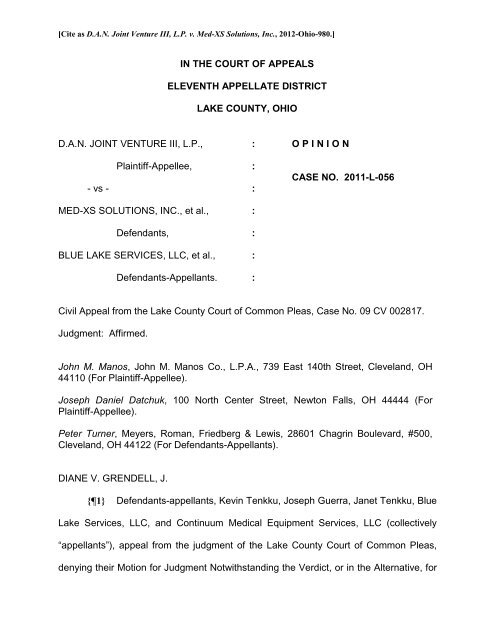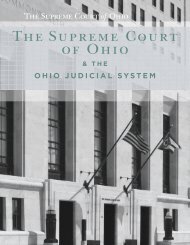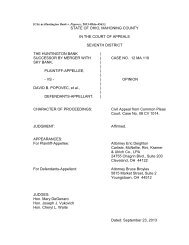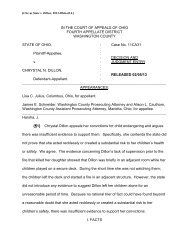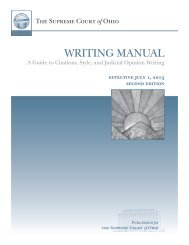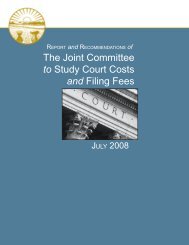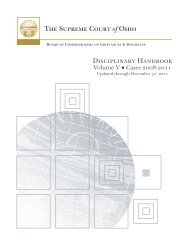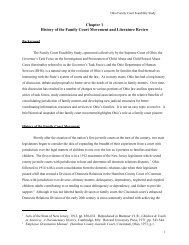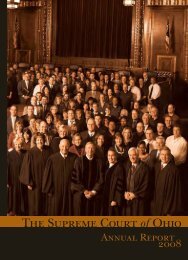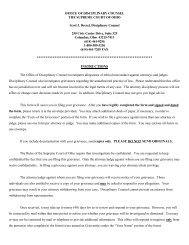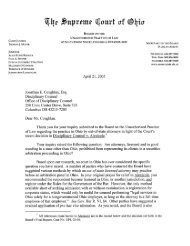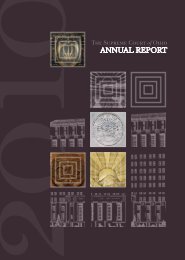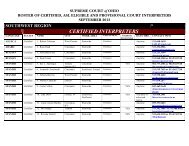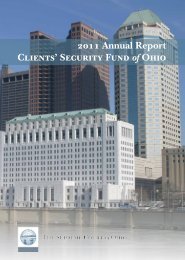DAN Joint Venture III, LP v. Med-XS Solutions, Inc. - Supreme Court
DAN Joint Venture III, LP v. Med-XS Solutions, Inc. - Supreme Court
DAN Joint Venture III, LP v. Med-XS Solutions, Inc. - Supreme Court
Create successful ePaper yourself
Turn your PDF publications into a flip-book with our unique Google optimized e-Paper software.
[Cite as D.A.N. <strong>Joint</strong> <strong>Venture</strong> <strong>III</strong>, L.P. v. <strong>Med</strong>-<strong>XS</strong> <strong>Solutions</strong>, <strong>Inc</strong>., 2012-Ohio-980.]<br />
IN THE COURT OF APPEALS<br />
ELEVENTH APPELLATE DISTRICT<br />
LAKE COUNTY, OHIO<br />
D.A.N. JOINT VENTURE <strong>III</strong>, L.P., : O P I N I O N<br />
Plaintiff-Appellee, :<br />
- vs - :<br />
MED-<strong>XS</strong> SOLUTIONS, INC., et al., :<br />
Defendants, :<br />
BLUE LAKE SERVICES, LLC, et al., :<br />
Defendants-Appellants. :<br />
CASE NO. 2011-L-056<br />
Civil Appeal from the Lake County <strong>Court</strong> of Common Pleas, Case No. 09 CV 002817.<br />
Judgment: Affirmed.<br />
John M. Manos, John M. Manos Co., L.P.A., 739 East 140th Street, Cleveland, OH<br />
44110 (For Plaintiff-Appellee).<br />
Joseph Daniel Datchuk, 100 North Center Street, Newton Falls, OH 44444 (For<br />
Plaintiff-Appellee).<br />
Peter Turner, Meyers, Roman, Friedberg & Lewis, 28601 Chagrin Boulevard, #500,<br />
Cleveland, OH 44122 (For Defendants-Appellants).<br />
DIANE V. GRENDELL, J.<br />
{¶1} Defendants-appellants, Kevin Tenkku, Joseph Guerra, Janet Tenkku, Blue<br />
Lake Services, LLC, and Continuum <strong>Med</strong>ical Equipment Services, LLC (collectively<br />
“appellants”), appeal from the judgment of the Lake County <strong>Court</strong> of Common Pleas,<br />
denying their Motion for Judgment Notwithstanding the Verdict, or in the Alternative, for
New Trial. Plaintiff-appellee, D.A.N. <strong>Joint</strong> <strong>Venture</strong> <strong>III</strong>, L.P. (D.A.N.) obtained a<br />
Judgment in the total amount of $2,197,391.20, following a trial in which the jury found<br />
that appellants committed a fraudulent transfer of property. The issues to be<br />
determined in this case are whether a party which receives a full judgment for a<br />
contractual debt may receive additional damages on a separate claim and whether the<br />
jury’s award of damages was speculative. For the following reasons, we affirm the<br />
decision of the court below.<br />
{¶2} <strong>Med</strong>-<strong>XS</strong> <strong>Solutions</strong>, <strong>Inc</strong>. (<strong>Med</strong>-<strong>XS</strong>) was a corporation located in Mentor,<br />
Ohio, formed by Kevin Tenkku and Joseph Guerra in 1997. <strong>Med</strong>-<strong>XS</strong> bought and sold<br />
used medical equipment to hospitals and provided other services, such as<br />
refurbishment of medical equipment.<br />
{¶3} On January 5, 2005, <strong>Med</strong>-<strong>XS</strong> took out a $2 million revolving line of credit<br />
and a $1 million five-year term loan from FirstMerit Bank, N.A. (FirstMerit). In order to<br />
secure these loans, FirstMerit received an interest in certain collateral, including all<br />
equipment, business assets, and receivable accounts of <strong>Med</strong>-<strong>XS</strong>. <strong>Med</strong>-<strong>XS</strong> was<br />
required to submit monthly borrowing base reports to FirstMerit which included, among<br />
other things, information about its total amount of accounts receivable, total inventory at<br />
cost, and prior advances. These loans were refinanced on September 13, 2005. At<br />
that time, FirstMerit loaned <strong>Med</strong>-<strong>XS</strong> $6 million on a revolving line of credit, with<br />
advances limited to the amount of 80% of accounts receivable plus 50% of qualified<br />
inventory, with a main purpose of the loan being to assist in the purchase of Health<br />
Quip, <strong>Inc</strong>. <strong>Med</strong>-<strong>XS</strong> was also loaned a $2 million term loan and a separate $200,000<br />
term loan. In 2006, two additional term loans were taken out, in the amounts of<br />
2
$700,000 and $419,115.57. Tenkku and Guerra signed personal guarantees on all<br />
loans from FirstMerit.<br />
{¶4} On October 2, 2006, Tenkku and Guerra formed Continuum <strong>Med</strong>ical<br />
Equipment Services (Continuum).<br />
{¶5} On October 19, 2006, D.A.N., a company which purchases distressed or<br />
troubled loans, and FirstMerit executed an Asset Sale Agreement, whereby FirstMerit<br />
sold to D.A.N. all of its rights under the <strong>Med</strong>-<strong>XS</strong> loan documents. At the time of this<br />
purchase, the unpaid balance of the loans totaled $8,983,916.75. D.A.N. purchased the<br />
loans for 80% of the amount owed, which totaled $7,187,133.40.<br />
{¶6} Subsequent to the purchase of the loans, D.A.N. informed <strong>Med</strong>-<strong>XS</strong> that it<br />
had purchased the right to collect on the outstanding loans. D.A.N. worked with <strong>Med</strong>-<br />
<strong>XS</strong> to set up a payment plan. In November of 2006, <strong>Med</strong>-<strong>XS</strong> agreed to make weekly<br />
payments to D.A.N. According to testimony from both sides, a breakdown in this<br />
relationship occurred.<br />
{¶7} On January 24, 2007, Tenkku and Guerra formed Blue Lake Services<br />
(Blue Lake), located in Painesville, which also was a company that dealt with hospitals<br />
and medical equipment.<br />
{¶8} On March 21, 2007, D.A.N. filed a Complaint in the Cuyahoga County<br />
<strong>Court</strong> of Common Pleas regarding the four term loans, asserting that <strong>Med</strong>-<strong>XS</strong>, Guerra,<br />
and Tenkku failed to repay the loans, and requesting payment of the loan balance and<br />
interest. The court entered a judgment by confession, or cognovit judgment, in favor of<br />
D.A.N. against <strong>Med</strong>-<strong>XS</strong>, Guerra, and Tenkku, totaling $3,264,631.30.<br />
3
{¶9} On August 2, 2007, D.A.N. filed a Complaint regarding the $6 million<br />
revolving line of credit in the Cuyahoga County <strong>Court</strong> of Common Pleas, asserting that<br />
<strong>Med</strong>-<strong>XS</strong>, Guerra, and Tenkku defaulted on the loan, and requesting the balance of the<br />
loan plus interest. Default judgment was granted against <strong>Med</strong>-<strong>XS</strong>, Guerra, and Tenkku,<br />
in the amount of $6,357,141.07.<br />
{¶10} On November 7, 2007, D.A.N. filed suit against FirstMerit, asserting that<br />
FirstMerit failed to reveal certain information to D.A.N. regarding its loans to <strong>Med</strong>-<strong>XS</strong><br />
and the value of the inventory and receivables serving as collateral. D.A.N. requested<br />
that the October 19, 2006 Asset Sale Agreement be rescinded. This suit was<br />
subsequently settled by the parties and FirstMerit paid a $5 million settlement to D.A.N.<br />
{¶11} On August 28, 2009, D.A.N. filed a Complaint in the Lake County <strong>Court</strong> of<br />
Common Pleas against various employees of <strong>Med</strong>-<strong>XS</strong>, including appellants. The<br />
Complaint contained three counts: Count 1, Fraud; Count 2, Fraudulent Conveyance;<br />
and Count 3, Enterprise Liability. The Complaint alleged that the defendants, working in<br />
the scope of their employment with <strong>Med</strong>-<strong>XS</strong>, submitted false and misleading financial<br />
documents to FirstMerit. It asserted that the documents misrepresented the value of<br />
<strong>Med</strong>-<strong>XS</strong>’s accounts receivable and inventory, thereby overstating the amount of<br />
collateral against which it could borrow from FirstMerit by several million dollars. The<br />
Complaint also alleged, under the Fraudulent Conveyance count, that the defendants<br />
improperly transferred the physical assets of <strong>Med</strong>-<strong>XS</strong> to Continuum and Blue Lake.<br />
{¶12} On November 20, 2009, defendants Guerra and Tenkku filed Motions to<br />
Dismiss the Complaint, asserting that it was barred by res judicata, since judgments on<br />
4
the loan had already been obtained in the Cuyahoga County <strong>Court</strong> of Common Pleas.<br />
These motions were denied by the trial court.<br />
{¶13} During the pendency of the lawsuit, various defendants were voluntarily<br />
dismissed by D.A.N. At the time the matter went to trial, the remaining parties were<br />
<strong>Med</strong>-<strong>XS</strong>, Kevin Tenkku, Joseph Guerra, Janet Tenkku, Blue Lake, Continuum, and<br />
Diana King, who was dismissed during the course of the trial.<br />
{¶14} A jury trial was held in this matter on January 24 through January 27,<br />
2011. The following pertinent testimony was presented.<br />
{¶15} Guerra, an owner of <strong>Med</strong>-<strong>XS</strong>, testified that the company bought<br />
equipment from hospitals and resold it to other hospitals. He explained that the<br />
company offered other services, such as conducting inventory for hospitals. He testified<br />
that, regarding the allegations that <strong>Med</strong>-<strong>XS</strong>’s equipment had been fraudulently<br />
transferred to his other businesses, any equipment moved to Blue Lake no longer<br />
belonged to <strong>Med</strong>-<strong>XS</strong> because the inventory or equipment moved was to “finish orders”<br />
made by <strong>Med</strong>-<strong>XS</strong> customers.<br />
{¶16} Tenkku, the other owner of <strong>Med</strong>-<strong>XS</strong>, also testified that “the only thing that<br />
was moved [to Painesville] was equipment that was already paid for by customers” of<br />
<strong>Med</strong>-<strong>XS</strong>. A video taken by Tenkku of the <strong>Med</strong>-<strong>XS</strong> warehouse in Mentor was presented,<br />
showing inventory that was left behind. Tenkku testified that the warehouse in Mentor<br />
was 25,200 square feet, while the warehouse in Painesville was only 500 square feet.<br />
{¶17} Daniel Cadle, the owner of D.A.N., testified that his company was<br />
contacted by FirstMerit to purchase <strong>Med</strong>-<strong>XS</strong>’s loans because “management wanted to<br />
sell the note” and because <strong>Med</strong>-<strong>XS</strong> had “bounced a bunch of checks.” Cadle testified<br />
5
that after purchasing the loan, <strong>Med</strong>-<strong>XS</strong> failed to make the required payments. He also<br />
explained that at some point, he became aware that <strong>Med</strong>-<strong>XS</strong> had moved to Painesville.<br />
He went to the address in Painesville and saw equipment similar to that in <strong>Med</strong>-<strong>XS</strong>’s<br />
Mentor warehouse, “just stacked full.” Based on these observations, he believed that<br />
the collateral on the loans D.A.N. purchased was moved from Mentor to Painesville.<br />
{¶18} Belinda Grassi, a CPA testifying for D.A.N., reviewed <strong>Med</strong>-<strong>XS</strong>’s records<br />
and testified that the value of <strong>Med</strong>-<strong>XS</strong>’s inventory value had been overstated in financial<br />
records submitted to FirstMerit, due to trades or “inventory swaps” that were conducted<br />
and improperly recorded. She believed that the value of the inventory in 2005 was<br />
overstated by $2 million and was overstated by $3 million in 2006. As of August 31,<br />
2006, she believed the value of <strong>Med</strong>-<strong>XS</strong>’s inventory would be around $4 million, instead<br />
of the over $9 million stated in its inventory records. 1<br />
{¶19} Karl Yurchiak, a former salesperson at <strong>Med</strong>-<strong>XS</strong>, testified that in 2006, he<br />
made some sales to customers while he was still working for <strong>Med</strong>-<strong>XS</strong> but, pursuant to<br />
instructions from Tenkku and Guerra, told customers that he was working for Blue Lake.<br />
He testified that he made sales from <strong>Med</strong>-<strong>XS</strong>’s inventory using the name Blue Lake.<br />
{¶20} Darryl Bammerlin was a warehouse employee at <strong>Med</strong>-<strong>XS</strong>, as well as at<br />
Blue Lake and Continuum. He testified that in early 2007, a move occurred from the<br />
Mentor <strong>Med</strong>-<strong>XS</strong> location to Painesville. He explained that the business in Painesville<br />
was operating as Blue Lake, not <strong>Med</strong>-<strong>XS</strong>. He believed between eight to twelve trailers<br />
of inventory were moved from the Mentor location to Painesville over the course of three<br />
1. Although D.A.N. states in its brief that Grassi testified her best estimate of the inventory value on<br />
August 31, 2006, was $4 million less than the total amount listed on the balance sheet, her testimony<br />
does not indicate this. She was asked to give her “best opinion of what the inventory value was as of<br />
August 31st, 2006,” to which she replied “I would venture to say four million dollars.”<br />
6
or four days. He explained that once the inventory was moved to Blue Lake in<br />
Painesville, he was instructed to re-label or renumber all of the inventory, which<br />
included a couple thousand items.<br />
{¶21} Paul Seibyl, a former <strong>Med</strong>-<strong>XS</strong> employee, testified that everything,<br />
including inventory and computer equipment, was moved from <strong>Med</strong>-<strong>XS</strong> in Mentor to<br />
Painesville, in two or three truckloads.<br />
{¶22} The jury returned a verdict in favor of all defendants on count one, Fraud.<br />
Regarding count two, Fraudulent Conveyance, the jury returned a verdict in favor of<br />
D.A.N. and awarded actual damages in the amount of $439,478.24 against each<br />
individual defendant, for total damages of $2,197,391.20. On count three, the jury<br />
found in favor of D.A.N. against all defendants, but awarded no money judgment.<br />
{¶23} On February 15, 2011, the defendants filed a Motion for Judgment<br />
Notwithstanding the Verdict or, in the Alternative, for New Trial. They asserted that<br />
D.A.N. failed to prove the fair market value of the transferred assets, the award of<br />
damages was speculative, and the award was duplicative of the judgments already<br />
rendered in favor of D.A.N in the Cuyahoga County <strong>Court</strong> of Common Pleas.<br />
{¶24} The trial court issued a Judgment Entry on April 4, 2011, denying the<br />
Motion. It held that, in construing the evidence most strongly in favor of the plaintiff,<br />
there was evidence of substantial probative value in support of the claim of fraudulent<br />
transfer and that a new trial should not be granted.<br />
{¶25} Appellants timely appeal and raise the following assignments of error:<br />
{¶26} “[1.] The trial court erred in failing to grant Appellants’ Motion for<br />
Judgment Notwithstanding the Verdict, or, In the Alternative, for a New Trial.<br />
7
{¶27} “[2.] The judgments against Appellants on Appellee’s fraudulent transfer<br />
claim are against the manifest weight of the evidence.<br />
{¶28} “[3.] The trial court erred as a matter of law in entering judgments against<br />
Appellants in violation of the rule against duplication of judgments.”<br />
{¶29} “[N]ot later than fourteen days after entry of judgment [following a jury<br />
trial], a party may move to have the verdict and any judgment entered thereon set aside<br />
and to have judgment entered in accordance with his motion; or if a verdict was not<br />
returned, such party, within fourteen days after the jury has been discharged, may move<br />
for judgment in accordance with his motion.” Civ.R. 50(B); Freeman v. Wilkinson, 65<br />
Ohio St.3d 307, 309, 603 N.E.2d 993 (1992).<br />
{¶30} “A motion for a new trial may be joined with this motion, or a new trial may<br />
be prayed for in the alternative.” Civ.R. 50(B). “A new trial may be granted to all or any<br />
of the parties and on all or part of the issues,” where “[t]he judgment is not sustained by<br />
the weight of the evidence.” Civ.R. 59(A)(6).<br />
{¶31} When considering a motion for judgment notwithstanding the verdict, “[t]he<br />
evidence adduced at trial and the facts established by admissions in the pleadings and<br />
in the record must be construed most strongly in favor of the party against whom the<br />
motion is made, and, where there is substantial evidence to support his side of the<br />
case, upon which reasonable minds may reach different conclusions, the motion must<br />
be denied.” Posin v. A.B.C. Motor <strong>Court</strong> Hotel, <strong>Inc</strong>., 45 Ohio St.2d 271, 275, 344<br />
N.E.2d 334 (1976). “In considering a motion for judgment notwithstanding the verdict, a<br />
court does not weigh the evidence or test the credibility of the witnesses.” Osler v.<br />
Lorain, 28 Ohio St.3d 345, 504 N.E.2d 19 (1986), syllabus; Posin at 275. Thus, the<br />
8
question is whether there is sufficient evidence regarding a particular issue for the trial<br />
court to submit the issue to the jury for determination. O’Day v. Webb, 29 Ohio St.2d<br />
215, 280 N.E.2d 896 (1972), paragraph four of the syllabus. “The question of whether a<br />
party is entitled to judgment notwithstanding the verdict is a question of law and, thus,<br />
requires a de novo review.” Arrow Machine Co., Ltd. v. Array Connector Corp., 11th<br />
Dist. No. 2010-L-115, 2011-Ohio-6513, ¶ 34, citing Environmental Network Corp. v.<br />
Goodman Weiss Miller, L.L.P., 119 Ohio St.3d 209, 2008-Ohio-3833, 893 N.E.2d 173, ¶<br />
23.<br />
{¶32} This court reviews a trial court’s judgment on a Civ.R. 59 motion for new<br />
trial under the abuse of discretion standard. Effingham v. XP3 Corp., 11th Dist. No.<br />
2006-P 0083, 2007-Ohio-7135, ¶ 18. “[I]n reviewing a motion for a new trial we do so<br />
with deference to the trial court’s decision, recognizing that ‘the trial judge is better<br />
situated than a reviewing court to pass on questions of witness credibility and the<br />
surrounding circumstances and atmosphere of the trial.’” Lanzone v. Zart, 11th Dist.<br />
No. 2007-L-073, 2008-Ohio-1496, ¶ 67, quoting Malone v. <strong>Court</strong>yard by Marriott L.P.,<br />
74 Ohio St.3d 440, 448, 659 N.E.2d 1242 (1996) (citation omitted).<br />
{¶33} We will consider the first and third assignments of error jointly.<br />
{¶34} In their first assignment of error, appellants assert that the trial court<br />
improperly denied the Motion for Judgment Notwithstanding the Verdict as to the<br />
damages on the fraudulent transfer claim because D.A.N. failed to present any<br />
evidence of the fair market value of <strong>Med</strong>-<strong>XS</strong>’s inventory. They argue that there was<br />
insufficient evidence in the record to support the jury’s award of $2,197,391.20 in<br />
damages and that it was speculative.<br />
9
{¶35} “As a general rule, once a plaintiff establishes a right to damages, that<br />
right will not be denied because the damages cannot be calculated with mathematical<br />
certainty.” (Citation omitted.) Barker v. Sundberg, 11th Dist. No. 92-A-1756, 1993 Ohio<br />
App. LEXIS 5112, *4 (Oct. 25, 1993) (citation omitted); Anderson v. Snyder, 11th Dist.<br />
No. 98-P-0013, 1999 Ohio App. LEXIS 3092, *7 (June 30, 1999). “However, damages<br />
will not be awarded based on mere speculation and conjecture” and must be<br />
“ascertainable with reasonable certainty.” Barker at *4; Bokar v. Lax, 8th Dist. No.<br />
75929, 2000 Ohio App. LEXIS 1654, *13 (Apr. 13, 2000) (a compensatory damages<br />
award in a fraudulent transfer case must not be speculative).<br />
{¶36} Although appellants argue that the value of the damages awarded was<br />
speculative, the record in the present case contains several pieces of evidence<br />
supporting the jury’s finding as to the value of the items transferred. D.A.N. presented<br />
<strong>Med</strong>-<strong>XS</strong>’s borrowing base reports for 2005 through September of 2006, as well as an<br />
August 2006 Inventory Report. The Report, which contained detailed records as to<br />
each of the items in <strong>Med</strong>-<strong>XS</strong>’s inventory and their value, showed <strong>Med</strong>-<strong>XS</strong>’s inventory to<br />
be valued at approximately $9.7 million. D.A.N. also submitted an August 31, 2006<br />
Balance Sheet, which listed an inventory value of the same amount. Appellants did not<br />
present any evidence disputing the value of the items contained in those reports,<br />
prepared by their own employees. In addition, an e-mail sent on December 5, 2006,<br />
from Kevin Tenkku to a D.A.N. employee confirmed that the inventory value contained<br />
in the August report was a “good number” and that any new inventory report in the<br />
future would not be “vastly different.” Grassi, the CPA, also testified that after reviewing<br />
all of the records related to the inventory, and accounting for the value that she believed<br />
10
to be overstated by <strong>Med</strong>-<strong>XS</strong>, the value of <strong>Med</strong>-<strong>XS</strong>’s inventory as of August 31, 2006,<br />
was approximately $4 million.<br />
{¶37} In addition, the testimony of several witnesses that all of the inventory<br />
from <strong>Med</strong>-<strong>XS</strong> had been moved around January of 2007 to Painesville, where Blue Lake<br />
and Continuum were located, supported a finding that all of the at least $4 million worth<br />
of inventory was fraudulently transferred. Both Bammerlin and Seibyl testified that the<br />
entire inventory was moved to Painesville, in several large truckloads. In addition,<br />
Yurchiak testified that he sold <strong>Med</strong>-<strong>XS</strong> inventory in Painesville under the name of Blue<br />
Lake. Although there was contrasting evidence presented through the testimony of<br />
Guerra and Tenkku as to whether the property was actually transferred, it was for the<br />
jury to make a decision as to whether such testimony was credible. Osler, 28 Ohio<br />
St.3d 345, 504 N.E.2d 19, at the syllabus (the credibility of witnesses is not for the court<br />
to determine when ruling on a motion for judgment notwithstanding the verdict). When<br />
considering both the testimony related to the value of the property and that all of the<br />
property had been transferred, the jury had substantial evidence before it to determine<br />
the value of damages to be awarded and did not award speculative damages.<br />
{¶38} Appellants also argue that the records from August of 2006 cannot<br />
establish the value of property transferred in January of 2007, which is when the<br />
transfer of property allegedly occurred. A review of the record, however, shows that<br />
<strong>Med</strong>-<strong>XS</strong>, as well as Blue Lake and Continuum, failed to provide any records<br />
establishing the value of the inventory after August of 2006. Tenkku testified at trial that<br />
Blue Lake and Continuum did not have any inventory records. The instructions given to<br />
the jury stated that it could find that “the failure of the Defendant to provide evidence of<br />
11
value under his control * * * places the risk of uncertainty” upon the defendant, not the<br />
plaintiff, which neither party argues was improper. In the present case, there was<br />
evidence to support a conclusion that appellants’ transfer of the property and failure to<br />
provide inventory records of the transferred property made it difficult for D.A.N. to<br />
provide exact values of the property. See Modic v. Modic, 91 Ohio App.3d 775, 783-<br />
784, 633 N.E.2d 1151 (8th Dist.1993) (where the defendant’s improper acts have<br />
caused a less than precise computation of damages, the plaintiff should be able to<br />
recover damages).<br />
{¶39} In addition, the e-mail from Tenkku to D.A.N. in December of 2006<br />
confirmed that the inventory value in the August 2006 reports was still “good,” lending<br />
further support to a finding that the August 2006 records were valid evidence to support<br />
a finding of the value of the inventory. Based on the foregoing, and even in light of<br />
appellants’ failure to present complete inventory records, there was still substantial<br />
evidence in the record to support the value of the jury’s award of damages, and the trial<br />
court did not err by denying the Motion for Judgment Notwithstanding the Verdict on the<br />
issue of the amount of damages awarded.<br />
{¶40} Finally, as asserted by D.A.N. and supported by the record, it argued to<br />
the jury that it requested damages only in the amount that it was out from the purchase<br />
of the loan from FirstMerit. Since D.A.N. purchased the loan for $7,187,133.40, the<br />
amount they had been damaged after the settlement of $5 million was $2,187.133.40.<br />
The jury’s total award of damages was $2,197,391.20. Although it is not the exact<br />
amount, it appears consistent with the argument made by D.A.N. at trial, thus lending<br />
12
further support to the finding that the jury believed the amount of the property<br />
transferred was at least the amount of its verdict, and was supported by the evidence.<br />
{¶41} Appellants finally argue that D.A.N.’s failure to have a receiver appointed<br />
contributed to the speculative nature of the damages. However, appellants point to no<br />
case law requiring D.A.N. to have a receiver appointed in order to prove damages.<br />
Moreover, as we find that the jury’s damages award was supported by substantial<br />
evidence, this argument is moot.<br />
{¶42} In their first and third assignments of error, appellants also argue that the<br />
judgment against them is in violation of the rule against duplication of judgments<br />
because D.A.N. already recovered judgments for the full value of the balance owed on<br />
the loans and also obtained a $5 million settlement from FirstMerit. Appellants assert<br />
that D.A.N. has suffered no additional loss from the fraudulent transfer above and<br />
beyond what has already been awarded in the other judgments.<br />
{¶43} D.A.N. argues that the damages were not duplicative because they were<br />
awarded for the actual taking of the property, not for the debt owed on the loans.<br />
{¶44} In the present case, the jury found that appellants made a fraudulent<br />
transfer of property from <strong>Med</strong>-<strong>XS</strong> to Blue Lake. Pursuant to R.C. 1336.04(A)(1), “[a]<br />
transfer made or an obligation incurred by a debtor is fraudulent as to a creditor,<br />
whether the claim of the creditor arose before or after the transfer was made or the<br />
obligation was incurred, if the debtor made the transfer or incurred the obligation * *<br />
* [w]ith actual intent to hinder, delay, or defraud any creditor of the debtor.”<br />
{¶45} On a fraudulent conveyance claim, a creditor may recover both<br />
compensatory and punitive damages, along with other forms of relief. Blood v.<br />
13
Nofzinger, 162 Ohio App.3d 545, 2005-Ohio-3859, 834 N.E.2d 358, ¶ 59-60 (6th Dist.).<br />
See R.C. 1336.07(A)(3)(c) (a creditor may obtain “[a]ny other relief that the<br />
circumstances may require”).<br />
{¶46} The amount of damages recoverable on a fraudulent transfer claim “will<br />
depend on the facts of each case and what is necessary to compensate the creditor for<br />
harm flowing from the fraud.” Blood at ¶ 59. A party injured by a fraudulent transfer “is<br />
entitled to recover such damages as will fairly compensate him for the wrong suffered;<br />
that is, the damages sustained by reason of the fraud or deceit, and which have<br />
naturally and proximately resulted therefrom.” Id., citing Aristocrat Lakewood Nursing<br />
Home v. Mayne, 133 Ohio App.3d 651, 671, 729 N.E.2d 768 (8th Dist.1999) (citation<br />
omitted). Regarding duplicative damages, “the fact that a plaintiff has separate and<br />
independent causes of action in contract and in tort does not permit him to recover more<br />
than the amount of damage actually suffered as a consequence of the injury resulting<br />
from the wrongful breach of his contract.” Davison Fuel & Dock Co. v. Pickands Mather<br />
& Co., 54 Ohio App.2d 177, 182, 376 N.E.2d 965 (1st Dist.1977) (citations omitted). A<br />
plaintiff must “allege and prove the existence of additional damages attributable” to the<br />
defendant to be awarded damages on each of the separate claims. (Emphasis sic.) Id.<br />
{¶47} In the present case, D.A.N. received two judgments against <strong>Med</strong>-<strong>XS</strong>,<br />
Tenkku, and Guerra in 2007, in the Cuyahoga County <strong>Court</strong> of Common Pleas.<br />
Together, those judgments totaled $9,621,772.37, which accounted for the entire<br />
amount of the loan balance owed, plus interest, at the time D.A.N. purchased the loans<br />
from FirstMerit. In addition, D.A.N. received a $5 million settlement from FirstMerit,<br />
which, when applied against the $7,187,133.40 paid to FirstMerit to purchase the loan,<br />
14
decreased the final amount D.A.N. failed to recover on its purchase price of the loan to<br />
$2,187,133.40.<br />
{¶48} Although appellants argue that the award of compensatory damages in<br />
the present case is duplicative since judgment has already been entered as outlined<br />
above, we note that courts have allowed creditors to recover compensatory damages in<br />
fraudulent transfer cases where a judgment has already been rendered against a debtor<br />
and has not been paid. See Profeta v. Lombardo, 75 Ohio App.3d 621, 626, 600<br />
N.E.2d 360 (11th Dist.1991) (a compensatory damages judgment was upheld on a<br />
fraudulent transfer even where creditor already had a judgment for damages on the<br />
underlying debt); Conley v. Smith, 6th Cir. No. 08-8021, 2008 Bankr. LEXIS 3447, *4<br />
(Bankr.2008) (where a fraudulent transfer occurred, the plaintiff was awarded the value<br />
of the property transferred in the amount of the unpaid judgment). In such cases, even<br />
though a full judgment was already awarded on the underlying debt, the amount of<br />
damages awarded on the fraudulent transfer claim was not treated as duplicative.<br />
{¶49} Although appellants assert that there are no additional damages above<br />
and beyond those that would already be satisfied if Tenkku, Guerra, and <strong>Med</strong>-<strong>XS</strong> made<br />
payment on the Cuyahoga County judgment, we note that neither party disputes that<br />
D.A.N. has not been able to recover on the judgments previously entered. In<br />
fraudulently transferring the physical inventory of <strong>Med</strong>-<strong>XS</strong>, the appellants have taken<br />
away D.A.N.’s ability to sell these assets and recover a portion of the prior judgment.<br />
Under appellants’ line of reasoning, any time a judgment is obtained, the creditor will not<br />
have recourse against the debtor for fraudulently transferring property, since they<br />
already had received a full judgment against the debtor. The purpose of the fraudulent<br />
15
transfer statute is to allow creditors to collect on the debts owed to them by debtors, not<br />
reward debtors for fraudulently transferring property.<br />
{¶50} Moreover, as noted by D.A.N., awarding damages on a fraudulent transfer<br />
claim is proper, even in light of an already existing judgment, because such an award<br />
raises separate concerns, such as being non-dischargeable in bankruptcy proceedings.<br />
See McClellan v. Cantrell, 217 F.3d 890, 895 (7th Cir.2000) (the court of appeals noted<br />
that, if the debtor had rendered a debt uncollectible by making a fraudulent transfer of<br />
the property that secured it, his actual fraud would give rise to a new debt,<br />
nondischargeable because it was created by fraud). To find the damages award<br />
duplicative would potentially prevent D.A.N. from being able to collect on the individual<br />
judgments in the future.<br />
{¶51} Therefore, D.A.N. was entitled to a judgment to recover for the collateral<br />
that was fraudulently transferred to the extent that it could not execute against that<br />
collateral to collect on the Cuyahoga County <strong>Court</strong> of Common Pleas judgments. Since<br />
neither of the parties assert that any payment has been made on such judgments,<br />
D.A.N. is entitled to recover up to that approximately $9.6 million award, provided that<br />
such a value of collateral was proven. In the present case, only $2,197,391.20 was<br />
awarded, and is therefore not duplicative.<br />
{¶52} We note that even if the $5 million settlement with FirstMerit was taken<br />
into account as being applicable to the judgments against Tenkku, Guerra, and <strong>Med</strong>-<strong>XS</strong><br />
for the purposes of determining whether the present judgment is duplicative, this would<br />
still leave D.A.N. with $4.6 million in damages unpaid under the Cuyahoga County<br />
judgments, well above the damages awarded by the jury.<br />
16
{¶53} Based on the foregoing, D.A.N. must be able to recover the amount of<br />
damages suffered due to the fraud, which in the present case is the value of the<br />
property D.A.N. was unable to sell in order to satisfy a portion of the debt owed to it by<br />
appellants. See Blood, 162 Ohio App.3d 545, 2005-Ohio-3859, 834 N.E.2d 358, at ¶<br />
59.<br />
{¶54} Appellants raise a similar argument in their third assignment of error,<br />
asserting that the trial court erred by failing to find that the rule against duplicative<br />
judgments was applicable. As addressed above, the law supports a finding that the<br />
judgment against appellants was not duplicative, and the trial court did not err in<br />
entering and accepting such a judgment.<br />
{¶55} The first and third assignments of error are without merit.<br />
{¶56} In their second assignment of error, appellants assert that the jury’s award<br />
of damages on the fraudulent transfer claim was against the manifest weight of the<br />
evidence.<br />
{¶57} Under the civil manifest weight of the evidence standard, “[j]udgments<br />
supported by some competent, credible evidence going to all the essential elements of<br />
the case will not be reversed by a reviewing court as being against the manifest weight<br />
of the evidence.” C.E. Morris Co. v. Foley Constr. Co., 54 Ohio St.2d 279, 376 N.E.2d<br />
578 (1978), syllabus. This presumption arises because the trier of fact has had the<br />
opportunity “to view the witnesses and observe their demeanor, gestures and voice<br />
inflections, and use these observations in weighing the credibility of the proffered<br />
testimony.” Seasons Coal Co., <strong>Inc</strong>. v. Cleveland, 10 Ohio St.3d 77, 80, 461 N.E.2d<br />
1273 (1984).<br />
17
{¶58} Appellants raise the same argument as in the first assignment of error,<br />
that the fair market value of the inventory was not established by the evidence.<br />
However, the weight of the evidence supports a finding that D.A.N. proved the damages<br />
with reasonable certainty, as discussed extensively above. When weighing the<br />
testimony of the <strong>Med</strong>-<strong>XS</strong> employees that all of the inventory had been moved, as well<br />
as the records showing the value of the inventory, against Tenkku and Guerra’s<br />
testimony that such property had not been moved, we cannot find that the jury’s verdict<br />
was against the weight of the evidence. The jury was in the best position to make a<br />
determination as to which parties were most credible. Id.<br />
{¶59} The second assignment of error is without merit.<br />
{¶60} Based on the foregoing, the judgment of the Lake County <strong>Court</strong> of<br />
Common Pleas, denying appellants’ Motion for Judgment Notwithstanding the Verdict,<br />
or in the Alternative, for New Trial, is affirmed. Costs to be taxed against appellants.<br />
TIMOTHY P. CANNON, P.J.,<br />
MARY JANE TRAPP, J.,<br />
concur.<br />
18


